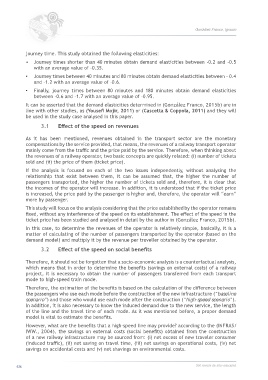Page 538 - 360.revista de Alta Velocidad - Nº 6
P. 538
González Franco, Ignacio
journey time. This study obtained the following elasticities:
• Journey times shorter than 40 minutes obtain demand elasticities between -0.2 and -0.5
with an average value of -0.35.
• Journey times between 40 minutes and 80 minutes obtain demand elasticities between - 0.4
and -1.2 with an average value of -0.6.
• Finally, journey times between 80 minutes and 180 minutes obtain demand elasticities
between -0.6 and -1.7 with an average value of -0.95.
It can be asserted that the demand elasticities determined in (González Franco, 2015b) are in
line with other studies, as (Yousefi Mojir, 2011) or (Cascetta & Coppola, 2011) and they will
be used in the study case analysed in this paper.
3.1 Effect of the speed on revenues
As it has been mentioned, revenues obtained in the transport sector are the monetary
compensations by the service provided, that means, the revenues of a railway transport operator
mainly come from the traffic and the price paid by the service. Therefore, when thinking about
the revenues of a railway operator, two basic concepts are quickly related: (i) number of tickets
sold and (ii) the price of them (ticket price).
If the analysis is focused on each of the two issues independently, without analysing the
relationship that exist between them, it can be assumed that, the higher the number of
passengers transported, the higher the number of tickets sold and, therefore, it is clear that
the incomes of the operator will increase. In addition, it is understood that if the ticket price
is increased, the price paid by the passenger is higher and, therefore, the operator will “earn”
more by passenger.
This study will focus on the analysis considering that the price established by the operator remains
fixed, without any interference of the speed on its establishment. The effect of the speed in the
ticket price has been studied and analysed in detail by the author in (González Franco, 2015b).
In this case, to determine the revenues of the operator is relatively simple, basically, it is a
matter of calculating of the number of passengers transported by the operator (based on the
demand model) and multiply it by the revenue per traveller obtained by the operator.
3.2 Effect of the speed on social benefits
Therefore, it should not be forgotten that a socio-economic analysis is a counterfactual analysis,
which means that in order to determine the benefits (savings on external costs) of a railway
project, it is necessary to obtain the number of passengers transferred from each transport
mode to high-speed train mode.
Therefore, the estimation of the benefits is based on the calculation of the difference between
the passengers who use each mode before the construction of the new infrastructure (“baseline
scenario”) and those who would use each mode after the construction (“high-speed scenario”).
In addition, it is also necessary to know the induced demand due to the new service, the length
of the line and the travel time of each mode. As it was mentioned before, a proper demand
model is vital to estimate the benefits.
However, what are the benefits that a high-speed line may provide? according to the (INFRAS/
IWW., 2004), the savings on external costs (social benefits) obtained from the construction
of a new railway infrastructure may be sourced from: (i) net excess of new traveler consumer
(induced traffic), (ii) net saving on travel time, (iii) net savings on operational costs, (iv) net
savings on accidental costs and (v) net shavings on environmental costs.
536 360.revista de alta velocidad

